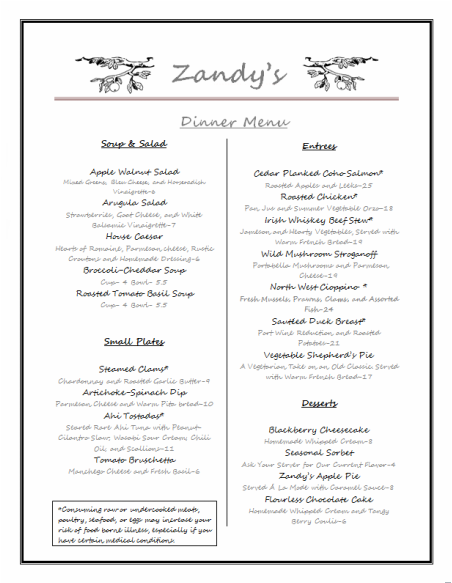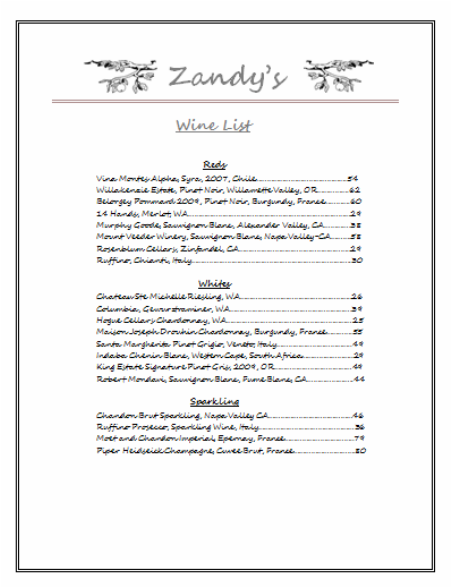Menu and Wine List

About the Wine Regions
Washington State is the second largest wine producer in the U.S.During the grape growing season, responsible for 99% of Washington’s wine grapes, Eastern Washington boasts warm summer days followed by cool nights, ensuring that grapes ripen fully while retaining ample natural acidity. Some of the wine making areas in Washington include: the Yakima Valley, Columbia Valley, Walla Walla Valley, and even the Puget Sound.
Oregon wineries are generally small and winemaker-or family-owned. Most of the wine regions lie in valleys between the southern Cascades which run through the state and it’s Coastal range to the west. The northwest portion of Oregon wine country is celebrated for its cool-climate grape varieties, including Pinot Gris, Riesling, Chardonnay, and especially Pinot noir.
California has a nearly perfect climate for wine making and its wine accounts for almost 90% of American wine production. The state's winemaking history goes all the way back to the 1700s when Spanish missionaries planted the first vineyards to produce wine for Mass. There are more than 1,200 wineries in the state today and California wines are distributed throughout the globe.
Chile is often overlooked as a wine region, but its production of wine began around the same time and for the same reasons as California wines. This diverse country has a multitude of climates, geographical conditions, and soil compositions which make sustainable vineyards a logical choice.
Washington State is the second largest wine producer in the U.S.During the grape growing season, responsible for 99% of Washington’s wine grapes, Eastern Washington boasts warm summer days followed by cool nights, ensuring that grapes ripen fully while retaining ample natural acidity. Some of the wine making areas in Washington include: the Yakima Valley, Columbia Valley, Walla Walla Valley, and even the Puget Sound.
Oregon wineries are generally small and winemaker-or family-owned. Most of the wine regions lie in valleys between the southern Cascades which run through the state and it’s Coastal range to the west. The northwest portion of Oregon wine country is celebrated for its cool-climate grape varieties, including Pinot Gris, Riesling, Chardonnay, and especially Pinot noir.
California has a nearly perfect climate for wine making and its wine accounts for almost 90% of American wine production. The state's winemaking history goes all the way back to the 1700s when Spanish missionaries planted the first vineyards to produce wine for Mass. There are more than 1,200 wineries in the state today and California wines are distributed throughout the globe.
Chile is often overlooked as a wine region, but its production of wine began around the same time and for the same reasons as California wines. This diverse country has a multitude of climates, geographical conditions, and soil compositions which make sustainable vineyards a logical choice.

About the Wine Regions Cont.
France:
Burgundy is one of France’s most famous wine regions, and well known for Pinot Noir and Chardonnay. The vineyards of Burgundy are split into tiny plots of land, some only containing one or two rows of vines! This results in blends of wines.
Champagne produces wines of celebration! No other wine is associated with joy and festivities. This region’s cold climate and short growing
season were originally responsible for the characteristic champagne bubbles. Although there are more modern ways of producing a sparkling wine, the Méthod Champenois is still the preferred method of making champagne.
Italy is home to some of the world’s oldest wine-producing regions in the world and is responsible for about one-fifth of the word’s wine production. Most Italian wines are grown in the northern portion where the climate is much more temperate in comparison to the South, which is too hot for wine growing. The three major wine regions in Italy are Tuscany, Piedmont, and Veneto.
South Africa is not exactly the first country that comes to mind when one thinks of good wine, at least not among Americans. In fact, many people do not associate South Africa with wine at all, but wines have been grown in South Africa for hundreds of years. Wine production is concentrated around Cape Town and major vineyard and production centers at Paarl, Stellenbosch and Worcester. This area has a Mediterranean climate with intense sunlight and dry heat and coastal influences from the Indian and Atlantic Oceans. This area is known for Cabernet Sauvignon.
go to Annual Sales Forecast
France:
Burgundy is one of France’s most famous wine regions, and well known for Pinot Noir and Chardonnay. The vineyards of Burgundy are split into tiny plots of land, some only containing one or two rows of vines! This results in blends of wines.
Champagne produces wines of celebration! No other wine is associated with joy and festivities. This region’s cold climate and short growing
season were originally responsible for the characteristic champagne bubbles. Although there are more modern ways of producing a sparkling wine, the Méthod Champenois is still the preferred method of making champagne.
Italy is home to some of the world’s oldest wine-producing regions in the world and is responsible for about one-fifth of the word’s wine production. Most Italian wines are grown in the northern portion where the climate is much more temperate in comparison to the South, which is too hot for wine growing. The three major wine regions in Italy are Tuscany, Piedmont, and Veneto.
South Africa is not exactly the first country that comes to mind when one thinks of good wine, at least not among Americans. In fact, many people do not associate South Africa with wine at all, but wines have been grown in South Africa for hundreds of years. Wine production is concentrated around Cape Town and major vineyard and production centers at Paarl, Stellenbosch and Worcester. This area has a Mediterranean climate with intense sunlight and dry heat and coastal influences from the Indian and Atlantic Oceans. This area is known for Cabernet Sauvignon.
go to Annual Sales Forecast
